Physiological and Psychological Effects of Viewing a Kiwifruit (Actinidia deliciosa ‘Hayward’) Orchard Landscape in Summer in Japan
Abstract
:1. Introduction
2. Experimental Section
2.1. Experimental Areas
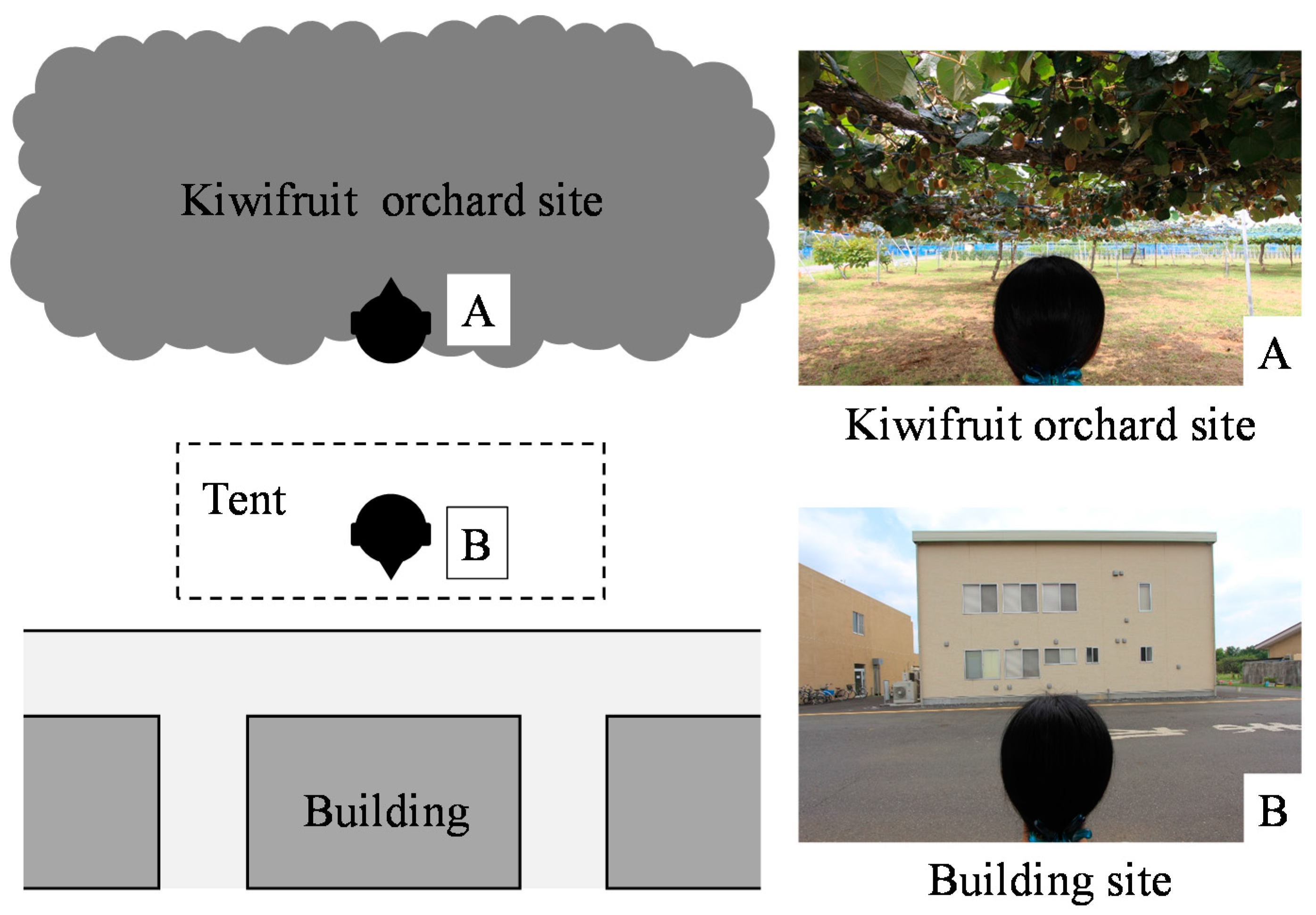
2.2. Subjects
2.3. Procedure
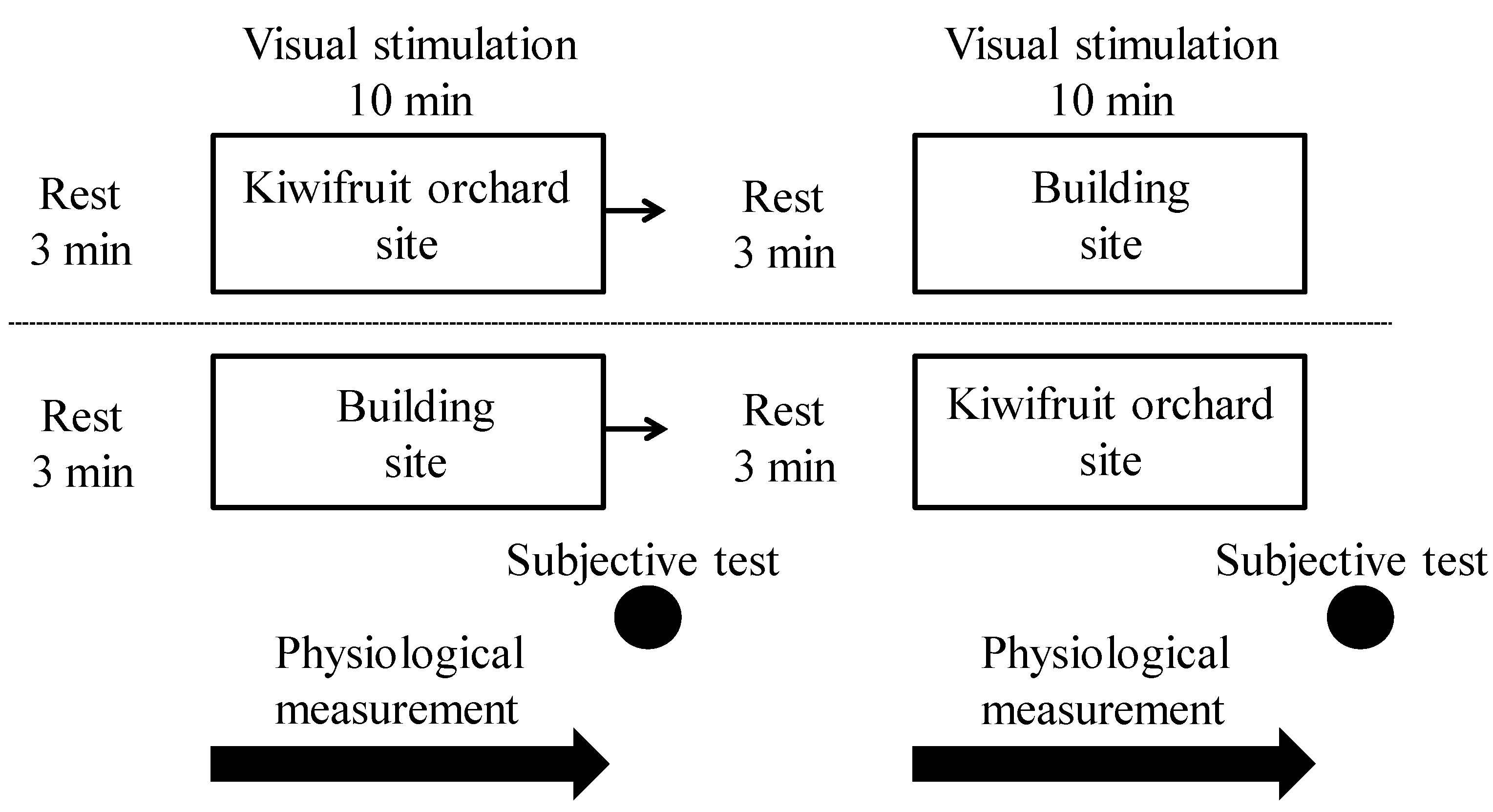
2.4. Physiological Measurement
2.5. Psychological Measurement
2.6. Statistical Analysis
3. Results
3.1. Physiological Effects
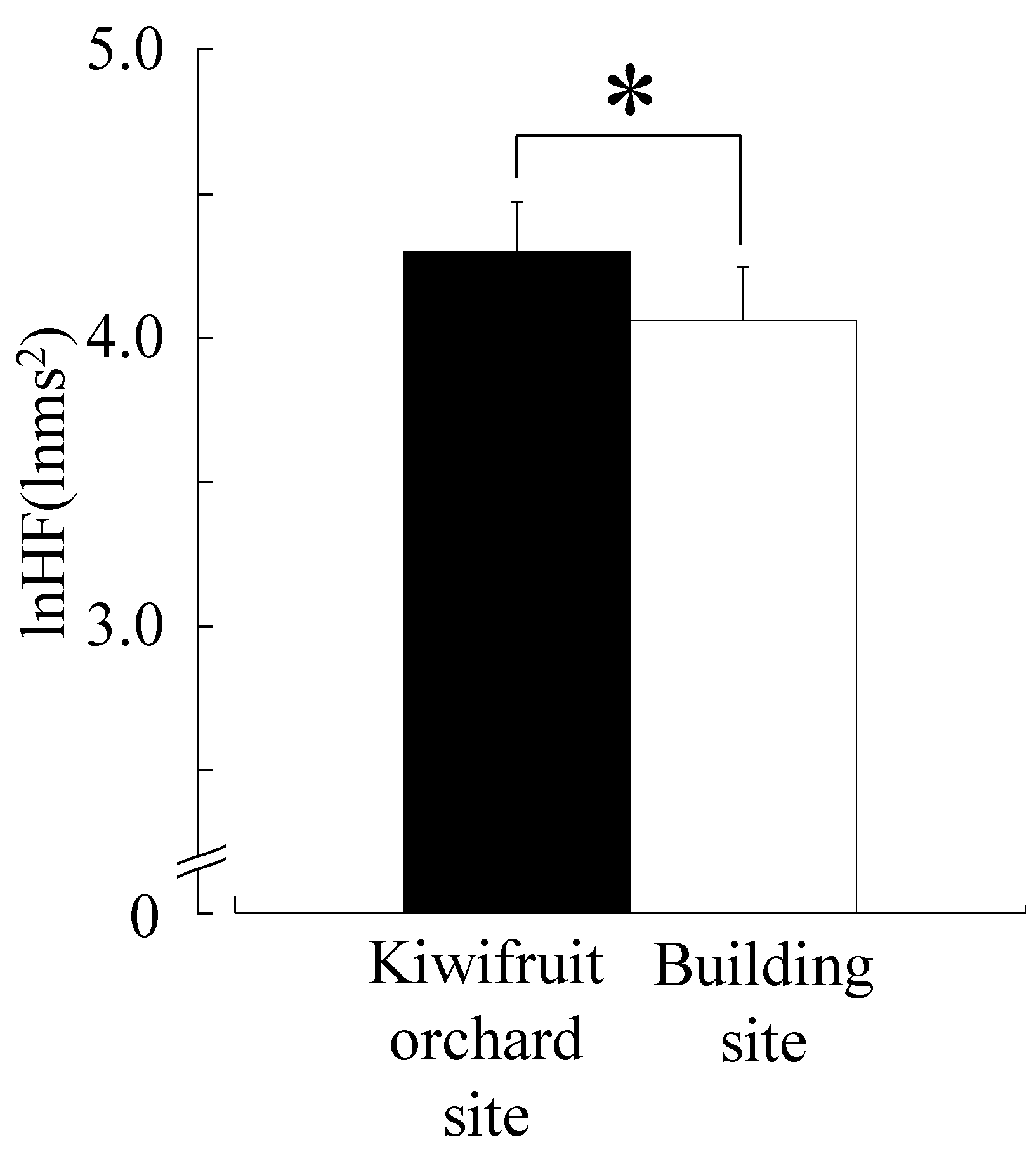
3.2. Psychological Effects
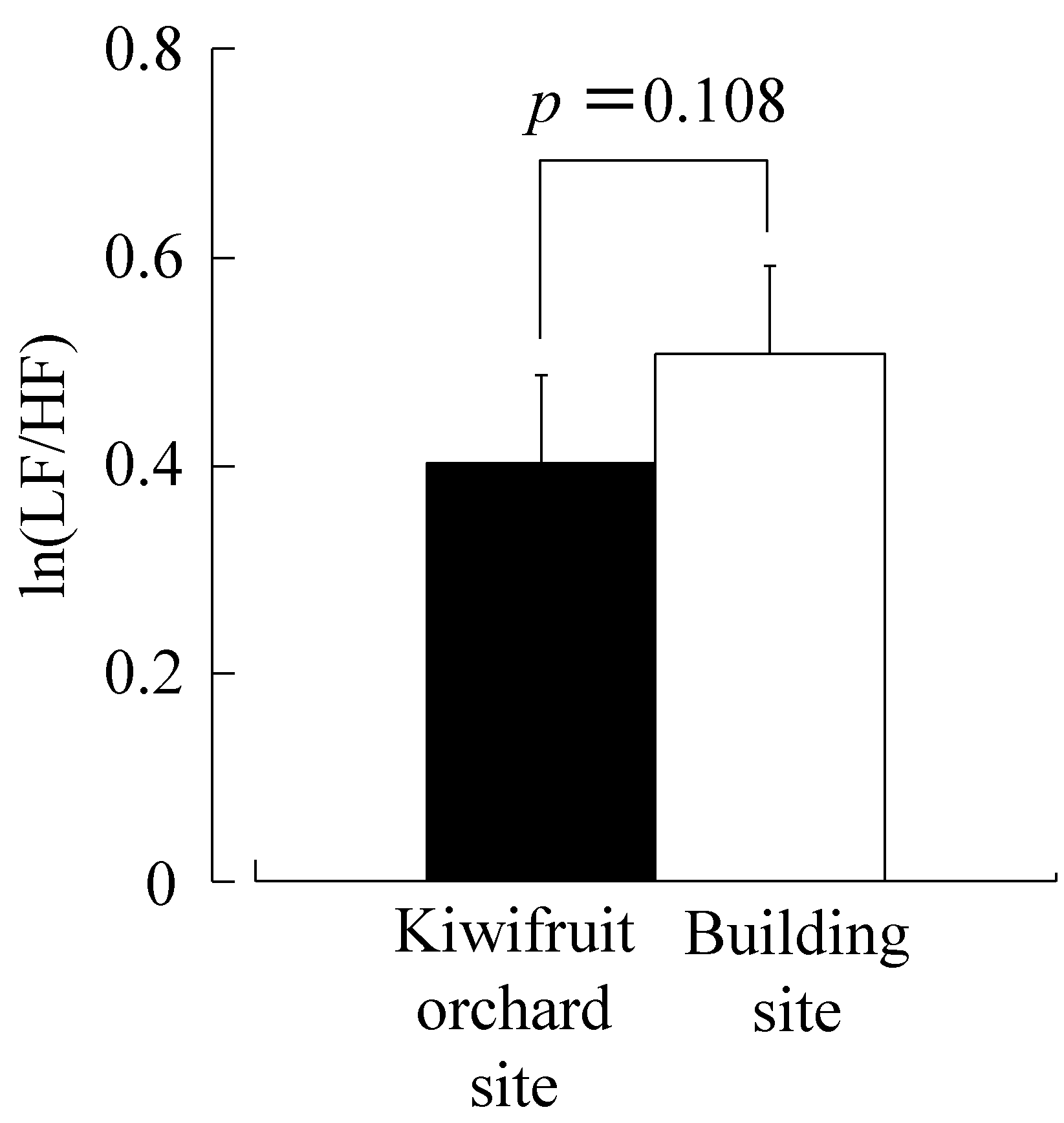


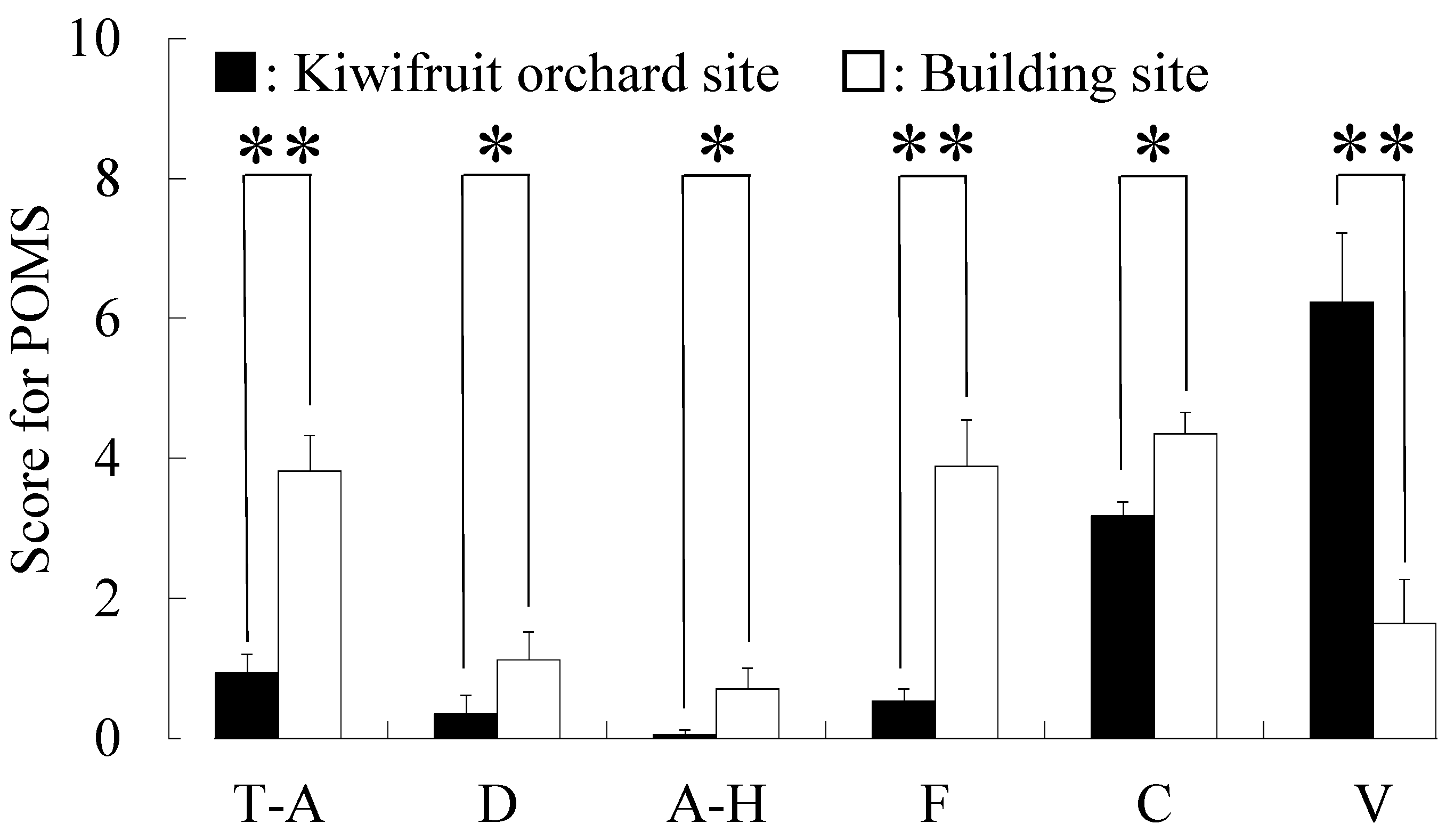
4. Discussion
5. Conclusions
Acknowledgments
Author Contributions
Conflicts of Interest
References
- Krabbendam, L.; van Os, J. Schizophrenia and urbanicity: a major environmental influence—Conditional on genetic risk. Schizophr. Bull. 2005, 31, 795–799. [Google Scholar] [CrossRef] [PubMed]
- Spauwen, J.; Krabbendam, L.; Lieb, R.; Wittchen, H.U.; van Os, J. Does urbanicity shift the population expression of psychosis? J. Psychiatr. Res. 2004, 38, 613–618. [Google Scholar] [CrossRef] [PubMed]
- Ulrich, R.S. Biophilia, biophobia, and natural landscapes. In The Biophilia Hypothesis; Kellert, S.P., Wilson, E.O., Eds.; Shearwater Book Island Press: Washington, D.C., USA, 1993; pp. 73–137. [Google Scholar]
- Parsons, R. The potential influences of environmental perception on human health. J. Environ. Psychol. 1991, 11, 1–23. [Google Scholar] [CrossRef]
- Hartig, T.; Mang, M.; Evans, G.W. Restorative effects of natural environment experiences. Environ. Behav. 1991, 23, 3–26. [Google Scholar] [CrossRef]
- Morimoto, K.; Miyazaki, Y.; Hirano, H. Forest Medicine; Asakura Publishing Co., Ltd.: Tokyo, Japan, 2006. (In Japanese) [Google Scholar]
- Lee, J.; Park, B.J.; Tsunetsugu, Y.; Ohira, T.; Kagawa, T.; Miyazaki, Y. Effect of forest bathing on physiological and psychological responses in young Japanese male subjects. Public Health 2011, 125, 93–100. [Google Scholar] [CrossRef] [PubMed]
- Lee, J.; Li, Q.; Tyrväinen, L.; Tsunetsugu, Y.; Park, B.J.; Kagawa, T.; Miyazaki, Y. Nature therapy and preventive medicine. In Public Health-Social and Behavioral Health; Maddock, J.R., Ed.; InTech: Rijeka, Croatia, 2012. [Google Scholar]
- Park, B.J.; Tsunetsugu, Y.; Ishii, H.; Furuhashi, S.; Hirano, H.; Kagawa, T.; Miyazaki, Y. Physiological effects of Shinrin-yoku (taking in the atmosphere of the forest) in a mixed forest in Shinano Town, Japan. Scand. J. Forest Res. 2008, 23, 278–283. [Google Scholar] [CrossRef]
- Park, B.J.; Tsunetsugu, Y.; Kasetani, T.; Morikawa, T.; Kagawa, T.; Miyazaki, Y. Physiological effects of forest recreation in a young conifer forest in Hinokage Town, Japan. Silva. Fennica. 2009, 43, 291–301. [Google Scholar] [CrossRef]
- Park, B.J.; Tsunetsugu, Y.; Kasetani, T.; Kagawa, T.; Miyazaki, Y. The physiological effects of Shinrin-yoku (taking in the forest atmosphere or forest bathing): Evidence from field experiments in 24 forests across Japan. Environ. Health Prev. Med. 2010, 2010, 15, 18–26. [Google Scholar] [CrossRef] [PubMed]
- Tsunetsugu, Y.; Park, B.J.; Ishii, H.; Hirano, H.; Kagawa, T.; Miyazaki, Y. Physiological effects of Shinrin-yoku (taking in the atmosphere of the forest) in an old-growth broadleaf forest in Yamagata Prefecture, Japan. J. Physiol. Anthropol. 2007, 26, 135–142. [Google Scholar] [CrossRef] [PubMed]
- Park, B.J.; Tsunetsugu, Y.; Kasetani, T.; Hirano, H.; Kagawa, T.; Sato, M.; Miyazaki, Y. Physiological effects of Shinrin-yoku (taking in the atmosphere of the forest)—Using salivary cortisol and cerebral activity as indicators. J. Physiol. Anthropol. 2007, 26, 123–128. [Google Scholar] [CrossRef] [PubMed]
- Lee, J.; Park, B.J.; Tsunetsugu, Y.; Kagawa, T.; Miyazaki, Y. Restorative effects of viewing real forest landscapes, based on a comparison with urban landscapes. Scand. J. Forest Res. 2009, 24, 227–234. [Google Scholar] [CrossRef]
- Ministry of Agriculture, Forestry and Fisheries, 2014. Available online: http://www.maff.go.jp/j/nousin/nougyou/simin_noen/zyokyo.html (accessed on 9 June 2015).
- Van den Berg, A.E.; Custers, M.H.G. Gardening promotes neuroendocrine and affective restoration from stress. J. Health Psychol. 2011, 16, 3–11. [Google Scholar]
- Mizuno, K.; Inoue, Y.; Tanaka, H.; Komada, Y.; Saito, H.; Mishima, K.; Shirakawa, S. Heart rate variability under acute simulated microgravity during daytime waking state and nocturnal sleep: Comparison of horizontal and 6 degrees head-down bed rest. Neurosci. Lett. 2005, 383, 115–120. [Google Scholar] [CrossRef] [PubMed]
- Sato, M.; Kanikowska, D.; Iwase, S.; Nishimura, N.; Shimizu, Y.; Belin de Chantemele, E.; Matsumoto, T.; Inukai, Y.; Taniguchi, Y.; Ogata, A.; Sugenoya, J. Effects of immersion in water containing high concentrations of CO2 (CO2-water) at thermoneutral on thermoregulation and heart rate variability in humans. Int. J. Biometeorol. 2009, 53, 25–30. [Google Scholar] [CrossRef] [PubMed]
- Task force of the European society of cardiology and the North American society of pacing and electrophysiology. Heart rate variability standards of measurement, physiological interpretation and clinical use. Circulation 1996, 93, 1043–1065. [Google Scholar]
- Pagani, M.; Lombardi, F.; Guzzetti, S.; Rimoldi, O.; Furlan, R.; Pizzinelli, P.; Sandrone, G.; Malfatto, G.; Dell'Orto, S.; Piccaluga, E. Power spectral analysis of heart rate and arterial pressure variabilities as a marker of sympatho-vagal interaction in man and conscious dog. Circ. Res. 1986, 59, 178–193. [Google Scholar] [CrossRef] [PubMed]
- Kobayashi, H.; Park, B.J.; Miyazaki, Y. Normative references of heart rate variability and salivary alpha-amylase in a healthy young male population. J. Physiol. Anthropol. 2012. [Google Scholar] [CrossRef] [PubMed]
- Osgood, C.E.; Suci, G.J.; Tannenbaum, P. The Measurement of Meaning; Univ Illinois Press: Urbana and Chicago, IL, USA, 1957. [Google Scholar]
- McNair, D.M.; Lorr, M. An analysis of mood in neurotics. J. Abnorm Soc. Psychol 1964, 69, 620–627. [Google Scholar] [CrossRef]
- McNair, D.M.; Lorr, M.; Droppleman, L.F. Profile of Mood States; Educational and Industrial Testing Service: San Diego, CA, USA, 1992. [Google Scholar]
- Yokoyama, K. POMS Shortened Version-Manual and Commentary on Cases; Kaneko Shoboh: Tokyo, Japan, 2005. [Google Scholar]
- Tsunetsugu, Y.; Lee, J.; Park, B.J.; Tyrväinen, L.; Kagawa, T.; Miyazaki, Y. Physiological and psychological effects of viewing urban forest landscapes assessed by multiple measurement. Landscape Urban. Plan. 2013, 113, 90–93. [Google Scholar] [CrossRef]
- Lee, J.; Tsunetsugu, Y.; Takayama, N.; Park, B.J.; Li, Q.; Song, C.; Komatsu, M.; Ikei, H.; Tyrväinen, L.; Kagawa, T.; Miyazaki, Y. Influence of forest therapy on cardiovascular relaxation in young adults. Evid. Based Complement. Alternat. Med. 2014. [Google Scholar] [CrossRef] [PubMed]
- Song, C.; Joung, D.; Ikei, H.; Igarashi, M.; Aga, M.; Park, B.J.; Miwa, M.; Takagaki, M.; Miyazaki, Y. Physiological and psychological effects of walking on young males in urban parks in winter. J. Physiol. Anthropol. 2013. [Google Scholar] [CrossRef] [PubMed]
- Song, C.; Ikei, H.; Igarashi, M.; Miwa, M.; Takagaki, M.; Miyazaki, Y. Physiological and psychological responses of young males during spring-time walks in urban parks. J. Physiol. Anthropol. 2014. [Google Scholar] [CrossRef] [PubMed]
- Li, Q.; Morimoto, K.; Nakadai, A.; Inagaki, H.; Katsumata, M.; Shimizu, T.; Hirata, Y.; Hirata, K.; Suzuki, H.; Miyazaki, Y.; et al. Forest bathing enhances human natural killer activity and expression of anti-cancer proteins. Int. J. Immunopathol. Pharmacol. 2007, 20, 3–8. [Google Scholar] [PubMed]
- Li, Q.; Morimoto, K.; Kobayashi, M.; Inagaki, H.; Katsumata, M.; Hirata, Y.; Hirata, K.; Shimizu, T.; Li, Y.; Wakayama, Y.; et al. A forest bathing trip increases human natural killer activity and expression of anti-cancer proteins in female subjects. J. Biol. Regul. Homeos. Agents. 2008, 22, 45–55. [Google Scholar]
- Li, Q.; Morimoto, K.; Kobayashi, M.; Inagaki, H.; Katsumata, M.; Hirata, Y.; Hirata, K.; Suzuki, H.; Li, Y.J.; Wakayama, Y.; et al. Visiting a forest, but not a city, increases human natural killer activity and expression of anti-cancer proteins. Int. J. Immunopathol. Pharmacol. 2008, 21, 117–127. [Google Scholar] [PubMed]
- Park, B.J.; Furuya, K.; Kasetani, T.; Takayama, N.; Kagawa, T.; Miyazaki, Y. Relationship between psychological responses and physical environment in forest settings. Landscape Urban. Plan. 2011, 102, 24–32. [Google Scholar] [CrossRef]
- Lee, M.S.; Park, B.J.; Lee, J.; Park, K.T.; Ku, J.H.; Lee, J.W.; Oh, K.O.; Miyazaki, Y. Physiological relaxation induced by horticultural activity: Transplanting work using flowering plants. J. Physiol. Anthropol. 2013. [Google Scholar] [CrossRef] [PubMed]
- Wichrowski, M.; Whiteson, J.; Haas, F.; Mola, A.; Rey, M.J. Effects of horticultural therapy on mood and heart rate in patients participating in an inpatient cardiopulmonary rehabilitation program. J. Cardiopulm. Rehabil. 2005, 25, 270–274. [Google Scholar] [CrossRef] [PubMed]
© 2015 by the authors; licensee MDPI, Basel, Switzerland. This article is an open access article distributed under the terms and conditions of the Creative Commons Attribution license (http://creativecommons.org/licenses/by/4.0/).
Share and Cite
Igarashi, M.; Miwa, M.; Ikei, H.; Song, C.; Takagaki, M.; Miyazaki, Y. Physiological and Psychological Effects of Viewing a Kiwifruit (Actinidia deliciosa ‘Hayward’) Orchard Landscape in Summer in Japan. Int. J. Environ. Res. Public Health 2015, 12, 6657-6668. https://doi.org/10.3390/ijerph120606657
Igarashi M, Miwa M, Ikei H, Song C, Takagaki M, Miyazaki Y. Physiological and Psychological Effects of Viewing a Kiwifruit (Actinidia deliciosa ‘Hayward’) Orchard Landscape in Summer in Japan. International Journal of Environmental Research and Public Health. 2015; 12(6):6657-6668. https://doi.org/10.3390/ijerph120606657
Chicago/Turabian StyleIgarashi, Miho, Masayuki Miwa, Harumi Ikei, Chorong Song, Michiko Takagaki, and Yoshifumi Miyazaki. 2015. "Physiological and Psychological Effects of Viewing a Kiwifruit (Actinidia deliciosa ‘Hayward’) Orchard Landscape in Summer in Japan" International Journal of Environmental Research and Public Health 12, no. 6: 6657-6668. https://doi.org/10.3390/ijerph120606657






